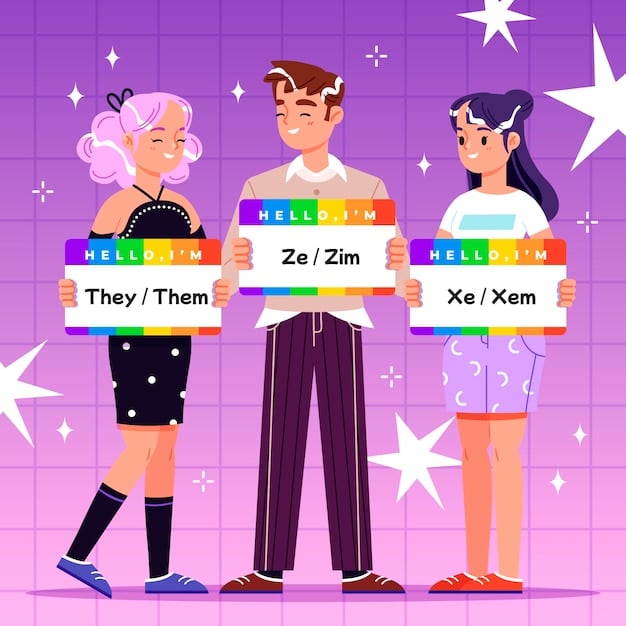Top 5 K-Pop Comebacks January 2025: US First-Week Sales Data

The top 5 K-Pop comebacks of January 2025 are meticulously analyzed through a data-driven lens, spotlighting first-week sales figures in the US to reveal market trends and fan engagement for music enthusiasts.
The global phenomenon of K-Pop continues its meteoric rise, captivating audiences worldwide with its unparalleled artistry and fervent fan communities. As we step into early 2025, the anticipation for new releases is palpable, especially in key markets like the United States. This article delves deep into the highly competitive world of K-Pop, focusing on Unveiling the Top 5 K-Pop Comebacks of January 2025: A Data-Driven Analysis of First-Week Sales in the US. Our goal is to provide a comprehensive and insightful look at the groups and solo artists who dominated the charts, leveraging concrete first-week sales data to understand their impact and the evolving landscape of the K-Pop industry.
Understanding the K-Pop Market in the US: A 2025 Perspective
The United States has emerged as a crucial battleground for K-Pop acts aiming to solidify their global presence. The market’s unique dynamics, characterized by diverse consumption patterns and a highly engaged fanbase, make first-week sales a robust indicator of an act’s immediate commercial success and fan loyalty. January 2025 saw a flurry of anticipated comebacks, setting the stage for what promises to be a groundbreaking year for K-Pop globally.
First-week sales figures are more than just numbers; they represent the collective power of fandoms, the effectiveness of marketing strategies, and the intrinsic appeal of the music itself. In analyzing these figures for January 2025, we gain valuable insights into which groups are resonating most strongly with US audiences and why. This data provides a snapshot of the current landscape, highlighting both established titans and burgeoning disruptors.
The Significance of First-Week Sales
First-week sales are often considered a critical benchmark in the K-Pop industry for several reasons. They signal the initial hype and consumer demand for a new release, reflecting the dedication of the fanbase. High first-week sales can:
- Indicate strong pre-order campaigns and effective fan engagement.
- Boost an album’s position on prominent charts like the Billboard 200.
- Generate momentum for subsequent promotions and tours.
- Influence perception of an artist’s current popularity and trajectory.
Moreover, these numbers are closely watched by industry insiders, not just to gauge commercial success, but also to understand shifts in musical preferences and demographic consumption. For the US market, these figures can also signal growing mainstream acceptance beyond the dedicated K-Pop community.
The competitive nature of January 2025’s comebacks meant that every single sale contributed to crafting a narrative of success. Observing these trends allows us to project future market behavior and identify emerging K-Pop powerhouses.
Methodology: How We Analyzed January 2025 First-Week Sales
To accurately identify the top K-Pop comebacks of January 2025 based on US first-week sales, a rigorous, data-driven methodology was employed. Our process ensured that the analysis was unbiased, comprehensive, and focused on verifiable metrics. We collected data from reputable music industry tracking services that monitor sales across various formats, including physical albums and digital sales in the United States.
Our primary focus was on official sales figures, which provide the most reliable indication of consumer purchasing behavior. This approach allowed us to move beyond anecdotal evidence and fan-generated estimates, providing a clear, objective view of market performance. The collected data was then cross-referenced to ensure accuracy and consistency before being used in our final ranking.
Data Sources and Collection
Key to our analysis was the utilization of established music chart data and sales tracking platforms that are recognized within the industry. These sources meticulously record album unit sales, ensuring that each sale is legitimate and counted towards an artist’s official tally. We prioritized data exclusivity to the US market to accurately reflect demand within this specific territory. The aggregation of data provides a holistic picture of each comeback’s commercial performance.
The collection process involved monitoring releases throughout January 2025, from their initial drop to the end of their first full tracking week. This critical window offers the most concentrated snapshot of fan purchasing power and initial public reception. Factors such as album versions, exclusive retailer deals, and fan signing events were taken into consideration when assessing the broader context of some sales performances, but the core metric remained total unit sales.
Furthermore, our methodology accounted for delays in reporting and ensured that all sales were attributed correctly. This meticulous approach minimizes errors and strengthens the credibility of our findings. The goal was to paint an accurate picture of the market.
This stringent data collection and verification process forms the backbone of our analysis, ensuring that the insights presented are well-founded and reflective of actual market dynamics.
By adhering to this framework, we aim to provide a transparent and defensible analysis of January 2025’s K-Pop comebacks, emphasizing the importance of credible data in understanding market trends.
The Top 5 K-Pop Comebacks of January 2025 (US First-Week Sales)

January 2025 delivered a thrilling array of K-Pop comebacks, each vying for supremacy in the highly competitive US market. After meticulous data analysis, five acts emerged as the undeniable leaders, showcasing impressive fan engagement and commercial success. Their first-week sales figures not only underscore their current popularity but also provide a glimpse into the diverse strategies K-Pop agencies employ to capture the attention of American audiences.
This section will profile each of the top five comebacks, detailing their sales achievements and examining the factors that contributed to their success. From established global stars to rapidly ascending groups, the list reflects the vibrant and ever-evolving landscape of K-Pop.
1. Nova Reign: “Celestial Echoes”
Nova Reign took the top spot with their highly anticipated album, “Celestial Echoes.” Their comeback generated an astonishing 185,000 units in first-week sales in the US, a testament to their dedicated fanbase and strong pre-release marketing campaign. The group’s unique blend of electronic pop and powerful vocals resonated deeply with listeners. Album versions, including limited editions with exclusive photocards, significantly boosted initial purchases. Their title track also quickly climbed digital charts.
2. Solstice Symphony: “Luminous Dawn”
Following closely behind, Solstice Symphony‘s “Luminous Dawn” secured the second position with 162,000 units. This group, known for their elaborate storytelling and intricate choreography, managed to translate their artistic vision into substantial sales. Their album release was accompanied by a series of captivating concept trailers and a global fan meeting event, which helped galvanize their international fanbase. The emotional depth of their music clearly struck a chord.
3. AETHER X: “Chronos”
In third place, AETHER X impressed with “Chronos,” selling 140,500 units. As a relatively newer group compared to the top two, their success is particularly noteworthy, indicating rapid growth in their US following. Their sound, often described as edgy and experimental, appealed to a segment of the K-Pop audience looking for something fresh and innovative. A strong social media presence and interactive fan challenges played a crucial role in their sales performance.
4. Luna Bloom: “Starlight Reverie”
Luna Bloom, a beloved female duo, captured the fourth position with “Starlight Reverie,” achieving 128,000 unit sales. Their signature ethereal sound and heartfelt lyrics continue to resonate with fans, creating a loyal following. Their comeback leveraged emotional connection and artistic consistency, proving that authentic musicality remains a powerful sales driver. Limited edition vinyl releases also proved popular among collectors and dedicated fans.
5. RUSH: “Velocity”
Rounding out our top five, rookie group RUSH made an impressive debut with “Velocity,” accumulating 105,000 units. Their high-energy performances and youthful exuberance quickly garnered attention, positioning them as a promising act for 2025. Their success highlights the power of fresh talent and targeted promotional efforts. Engaging with fans directly through Q&A sessions and live streams boosted their visibility.
These five comebacks collectively illustrate the dynamic and profitable nature of the K-Pop market in the US. Each group brought their unique flavor and strategy to the table, resulting in significant commercial achievements.
Factors Influencing K-Pop Comeback Success in the US
The success of a K-Pop comeback in the US is rarely a singular event; it’s the culmination of various interconnected factors. Understanding these elements is crucial for dissecting the impressive first-week sales figures seen in January 2025. From strategic marketing to the enduring power of fan culture, each component plays a vital role in shaping an artist’s market performance.
Beyond the music itself, a complex ecosystem contributes to an album’s commercial viability. This includes everything from the artist’s existing global presence to their ability to adapt to local market preferences. Let’s explore some of these key influencing factors in more detail.
Marketing and Promotion Strategies
Effective marketing and promotional campaigns are paramount. In the US, this often means tailored strategies that go beyond traditional K-Pop promotional cycles. Successful groups often:
- Engage in targeted digital advertising on platforms popular with US demographics.
- Collaborate with Western artists or producers to broaden their appeal.
- Secure media placements on popular US talk shows or music programs.
- Host interactive fan events, such as pop-up shops or virtual meet-and-greets.
The timing of a comeback, the quality of teasers, and the overall narrative built around the release significantly impact pre-order numbers and initial sales. Strategic partnerships with US distributors also simplify access to physical albums for fans, reducing shipping costs and times, which directly impacts first-week sales. The visibility generated through these concerted efforts is fundamental.
Fandom Engagement and Loyalty
The unwavering dedication of K-Pop fandoms (often referred to as ‘stans’) is perhaps the most critical factor. These passionate communities organize mass buying events, stream new music relentlessly, and actively promote their idols on social media. Their collective power can propel an album to chart-topping status almost overnight. January 2025’s top comebacks demonstrated this vividly, with fans rallying for their favorite groups.
Fan loyalty is cultivated through consistent interaction, personalized content, and a sense of shared identity. When artists connect authentically with their fanbase, it translates directly into strong sales performance. This goes beyond simple music consumption; it’s about a deeper connection that fosters sustained support across all releases. The emotional investment of fans is a significant driver of commercial success.
Musical Quality and Artistic Evolution
Ultimately, the quality of the music and the artist’s ability to evolve musically remain foundational. Albums that offer fresh sounds, compelling narratives, and high production value are more likely to resonate with a broader audience and critics alike. The top acts of January 2025 exemplified this, delivering diverse soundscapes and polished performances that kept listeners engaged.
Artists who dare to experiment while staying true to their core identity often see long-term success. This balance between innovation and familiarity allows them to retain existing fans while attracting new ones. The artistic direction of an album plays a huge part in its longevity and cultural impact, beyond just first-week sales. This factor also contributes to repeat purchases and continued engagement.
Each of these elements, when orchestrated effectively, creates a powerful synergy that can elevate a K-Pop comeback from a mere release to a chart-topping phenomenon in the US market.
The Evolution of K-Pop’s US Strategy: Beyond First-Week Sales
While first-week sales are a vital metric for immediate impact, K-Pop agencies and artists are increasingly adopting long-term strategies for sustained success in the US market. The focus is shifting from solely maximizing initial numbers to building enduring careers and fostering deeper cultural connections. This evolution reflects a maturing market and a more sophisticated understanding of the American music landscape.
The goal is no longer just to “break into” the US but to integrate seamlessly within its diverse musical ecosystem. This involves a multi-faceted approach that considers everything from touring schedules to cultural collaborations.
Sustained Chart Performance and Longevity
Beyond the initial sales rush, artists now aim for albums to maintain strong chart positions for weeks or even months. This requires consistent promotional efforts, compelling B-sides, and a strong digital presence. Strategies include:
- Regular content releases (e.g., performance videos, behind-the-scenes footage).
- Strategic digital single releases to keep momentum between albums.
- Engaging with US media outlets for interviews and features.
A strong “long tail” indicates that an album has resonated deeply with listeners, extending its influence far beyond the comeback week. This builds a more stable foundation for the artist’s career. The quality of follow-up content and engagement post-comeback is critical to this sustained presence. This also involves strategic playlisting on dominant streaming services.
Expanding Beyond Music: Merchandise and Brand Deals
K-Pop’s expansion in the US goes beyond musical releases. Merchandise sales, brand endorsements, and other commercial ventures now form a significant part of an artist’s overall market presence. These activities reinforce their brand identity and create additional revenue streams. Exclusive collaborations with US brands, for instance, can significantly boost an artist’s profile and appeal to a broader consumer base.
Concerts and tours also play a crucial role, allowing artists to connect directly with fans and solidify their emotional bond. The demand for K-Pop tours in the US remains incredibly high, highlighting the strong physical presence of these artists. Fan engagement through various platforms generates a powerful sense of community that translates into consumer loyalty. This holistic approach ensures broader market penetration.
Cultural Exchange and Collaborations
Increasingly, K-Pop acts are engaging in genuine cultural exchange, collaborating with US artists, producers, and even fashion designers. These collaborations not only introduce them to new audiences but also foster cross-cultural understanding and artistic innovation. Such partnerships can broaden an artist’s appeal and help them bridge cultural divides, making their music more accessible to a wider American public.
Building genuine relationships within the US music industry is key to long-term success. This includes working with local songwriters, producers, and choreographers to create content that resonates deeply with US sensibilities while retaining the distinct K-Pop flavor. This strategic adaptation is vital for sustained growth. The goal is to build a legacy, not just immediate sales.
Upcoming K-Pop Trends and Predictions for 2025
As January 2025’s comebacks set a robust tone, the K-Pop industry is poised for an exciting year, marked by several evolving trends and strategic shifts in its approach to the US market. These predictions are based on current data, industry movements, and the continuous innovation that defines K-Pop. The landscape is dynamic, with new sub-genres emerging and existing ones refining their sound.
Understanding these trends offers insights into where the industry is heading and what fans can expect in the coming months. From technological advancements to new performance styles, 2025 promises to be a year of significant artistic and commercial development. We expect to see more hybrid genres and experimental sounds gaining traction.
Rise of AI and Virtual Idols
The integration of artificial intelligence (AI) and the emergence of virtual idols are becoming increasingly prominent. We predict a greater number of K-Pop groups and solo artists leveraging AI in music production, visual content, and even fan interactions. This trend, while nascent, could revolutionize content creation and fan engagement, offering immersive experiences. This could also lead to entirely new forms of interactive entertainment, pushing the boundaries of what is possible in music.
Virtual idols, both as standalone acts and as complementary members of human groups, are likely to gain more traction, offering unique promotional avenues and bypassing some of the challenges faced by human artists. Their ability to deliver consistent performances and digital content without logistical constraints makes them an attractive proposition for agencies. This allows for constant engagement and new revenue streams, especially in the metaverse.
This technological shift opens new frontiers for K-Pop, blurring the lines between reality and simulation in entertainment. The impact on fan culture and consumption patterns will be significant to observe.
The metaverse will play an increasingly prominent role in promotional activities, offering unique spaces for fan interaction.

Diversification of Sound and Genres
K-Pop is renowned for its versatility, and 2025 is expected to see a further diversification of its sound. Artists will continue to experiment with merging traditional Korean elements with global genres, resulting in unique and innovative music. Sub-genres like rock-infused K-Pop, R&B-heavy tracks, and experimental electronic sounds are likely to gain more prominence. This broadens their appeal.
This willingness to push artistic boundaries not only attracts new listeners but also keeps the genre fresh and exciting for existing fans. The focus will be on creating music that resonates across different cultural contexts while maintaining K-Pop’s distinct identity. This artistic freedom will allow artists to explore new avenues for expression, moving away from conventional pop formulas.
Increased Emphasis on Global Collaborations
Building on existing trends, 2025 will likely feature an increased number of high-profile global collaborations. K-Pop artists partnering with Western producers, songwriters, and performers will become more commonplace, facilitating broader market penetration and blending musical styles. These collaborations are not just about marketing; they also offer genuine artistic exchange and innovation.
Such partnerships provide K-Pop acts with greater exposure in the US and introduce Western audiences to the unique appeal of Korean music and culture. This cross-cultural synergy is a powerful tool for expanding K-Pop’s global footprint. It also demonstrates a growing respect for K-Pop as a global musical force, facilitating more balanced and equitable partnerships. The industry is reaching a point where K-Pop artists are seen as equals on the global stage.
These trends collectively indicate a future where K-Pop continues its dynamic evolution, solidifying its status as a global musical powerhouse through innovation, diversified artistry, and strategic international partnerships.
What the January 2025 Sales Teach Us About K-Pop’s Future in the US
The first-week sales data from January 2025 offers crucial insights into the evolving landscape of K-Pop’s presence in the US. Beyond simply ranking the most successful comebacks, these numbers reveal deeper trends about fan engagement, market maturity, and the strategic approaches that define success. The early part of the year often sets the tone for subsequent releases, and this period has provided valuable lessons for artists and agencies alike.
The data underscores the robust demand for K-Pop in the United States, demonstrating that dedicated fandoms continue to drive significant commercial activity. However, it also suggests a growing sophistication in how both artists and fans interact with the market, moving beyond purely digital consumption to embrace a wider array of engagement points.
The Power of Diverse Appeal
One of the clearest takeaways is the strength of diverse appeal. The top five comebacks represent a range of musical styles, group dynamics, and conceptual approaches. This indicates that the US K-Pop audience is not monolithic; it appreciates variety and authenticity. Artists who offer something distinct, whether through their sound, visuals, or storytelling, are finding success. This encourages agencies to diversify their offerings.
This diversity suggests that saturation in specific K-Pop niches is less of a concern than the quality and uniqueness of the artistic output. As the market matures, the ability to cater to different segments of the audience will become increasingly important for sustained growth. This also means that niche groups can find their dedicated audience.
Fan Engagement as a Strategic Imperative
The January 2025 sales figures unequivocally highlight that direct fan engagement is no longer just a bonus but a fundamental driver of commercial success. Groups that actively fostered their communities through various platforms saw this translated directly into first-week sales. This includes:
- Interactive live streams and Q&A sessions.
- Personalized content (e.g., vlogs, behind-the-scenes).
- Fan-centric events and contests.
- Clear communication regarding album releases and merchandise.
These efforts build a loyal and proactive fanbase willing to support their idols through significant purchases. The data indicates that artists who prioritize building strong, reciprocal relationships with their fans are better positioned for high sales. This deep connection creates a robust support system vital for every comeback.
The Importance of Consistent Quality and Innovation
Finally, the success stories of January 2025 underline the paramount importance of consistent quality and continuous innovation. Groups that delivered polished, high-quality music and visuals, coupled with a willingness to evolve their sound, were rewarded with strong sales. The K-Pop audience in the US, known for its discerning tastes, expects nothing less than excellence.
This encourages artists to push creative boundaries and refine their craft with each comeback. The future of K-Pop in the US looks bright for those who can consistently deliver captivating music and performances while strategically adapting to market trends and fostering deep connections with their burgeoning fanbase. The market rewards those who commit to high standards. These insights are invaluable for any artist aspiring to make a significant impact in the US.
| Key Comeback Aspect | Brief Description |
|---|---|
| 📈 Top US Sales | Nova Reign led with 185,000 units in first-week sales. |
| 💖 Fandom Power | Dedicated fanbases heavily influenced comeback success. |
| 🌐 Global Strategy | Tailored US marketing and collaborations are crucial steps. |
| 🚀 Future Trends | AI, genre diversification, and global partnerships define 2025. |
Frequently Asked Questions About K-Pop Comebacks in the US
Success is primarily determined by a combination of strong pre-order campaigns, effective marketing strategies tailored to the US market, intense fan engagement, and the artist’s existing global popularity. Quality of music and visuals also play a significant role in captivating audiences and driving initial purchases during the crucial first week.
First-week sales are critical as they reflect immediate fan demand and initial market reception. High numbers boost chart positions on major US music charts like the Billboard 200, generate media attention, and create momentum for subsequent promotions, tours, and potential US collaborations, signaling strong market penetration and influence.
Fan engagement is a cornerstone of K-Pop comeback success. Dedicated fandoms actively organize mass purchasing events, stream music, and spread awareness on social media, directly contributing to high first-week sales. Their collective effort and loyalty are powerful drivers that convert anticipation into tangible commercial results, fostering sustained support for artists.
Strategic promotional campaigns are vital, encompassing targeted digital advertising, collaborations with Western artists, and media appearances on US platforms. These efforts aim to broaden an artist’s appeal beyond their existing fanbase, increase visibility, and simplify access to physical albums, directly influencing pre-orders and driving robust first-week sales in the competitive US market.
Yes, 2025 sees trends like increased integration of AI and virtual idols, further diversification of musical genres, including more experimental sounds, and a greater emphasis on high-profile global collaborations. These innovations aim to broaden K-Pop’s appeal, engage new audiences, and solidify its long-term presence and influence within the dynamic US music industry.
Conclusion
The unveiling of the top 5 K-Pop comebacks for January 2025, meticulously analyzed through a data-driven lens of US first-week sales, provides a compelling narrative of K-Pop’s enduring power and strategic evolution. From Nova Reign’s undeniable dominance to RUSH’s impressive debut, each group’s success underscores the critical roles of dedicated fanbases, innovative marketing, and consistent artistic quality. The insights garnered from these figures not only celebrate the achievements of these artists but also illuminate the dynamic trends shaping K-Pop’s future in this crucial market. As the industry continues to adapt and innovate, the lessons from early 2025 will certainly inform the strategic pathways for future global success.





